Corporate Accounting and Reporting: Impairment Analysis Report
VerifiedAdded on 2020/04/07
|8
|1685
|62
Report
AI Summary
This report provides an in-depth analysis of corporate accounting, with a specific focus on asset impairment according to IAS 36. The report explains the concept of impairment loss, detailing the situations in which it occurs and the assessment of asset values compared to their recoverable amounts. It examines the role of impairment indicators, both internal and external, and the process of determining the recoverable amount. The report also includes a practical application of these principles through a case study, presenting a scenario involving asset impairment and providing a journal entry to reflect the financial impact. It also includes a detailed breakdown of the impairment loss apportionment across different asset types, such as patents, equipment, and goodwill, demonstrating the practical application of accounting standards. The report also touches upon the challenges associated with impairment testing, including the subjectivity in valuation models and the potential for managerial discretion in earnings management, which can impact the comparability of financial statements.
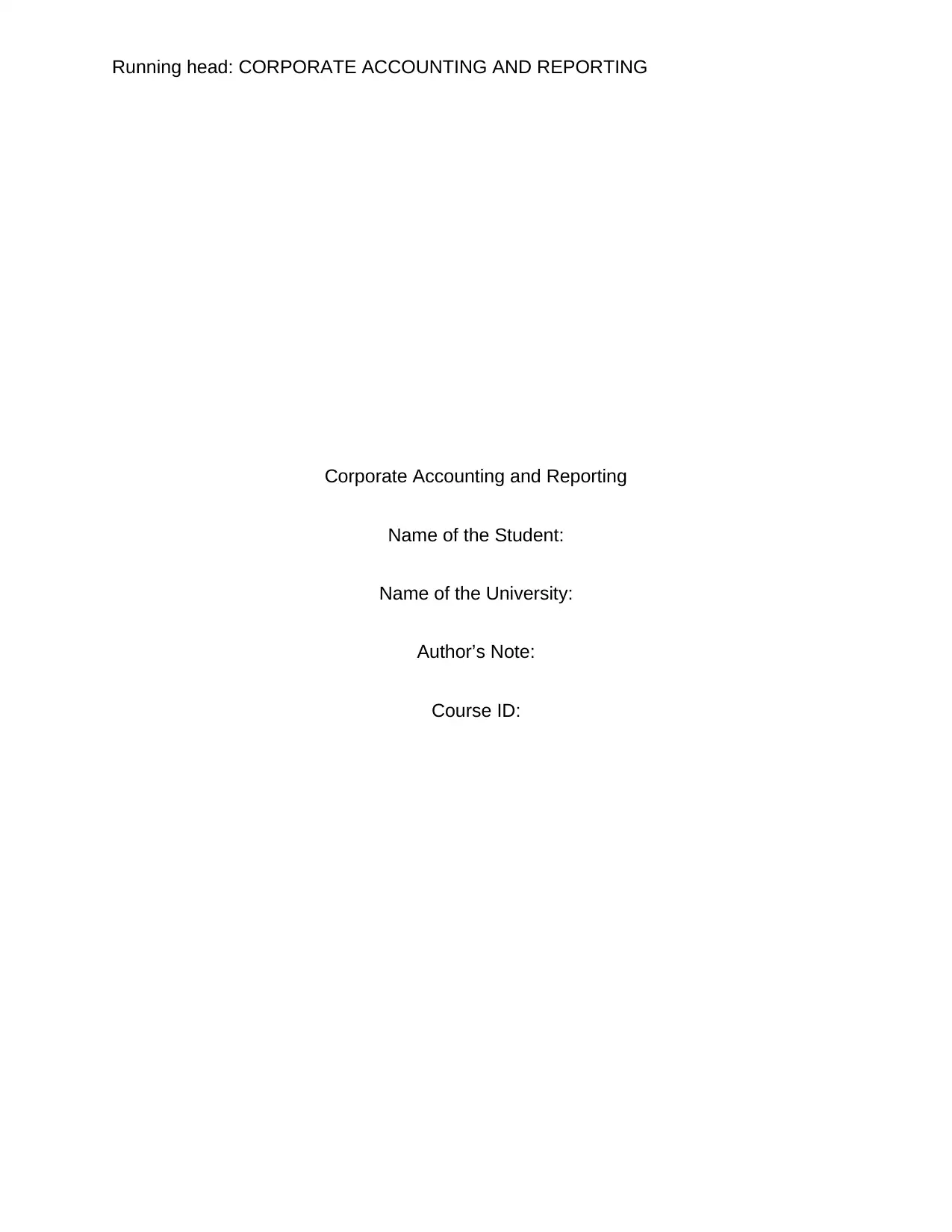
Running head: CORPORATE ACCOUNTING AND REPORTING
Corporate Accounting and Reporting
Name of the Student:
Name of the University:
Author’s Note:
Course ID:
Corporate Accounting and Reporting
Name of the Student:
Name of the University:
Author’s Note:
Course ID:
Paraphrase This Document
Need a fresh take? Get an instant paraphrase of this document with our AI Paraphraser
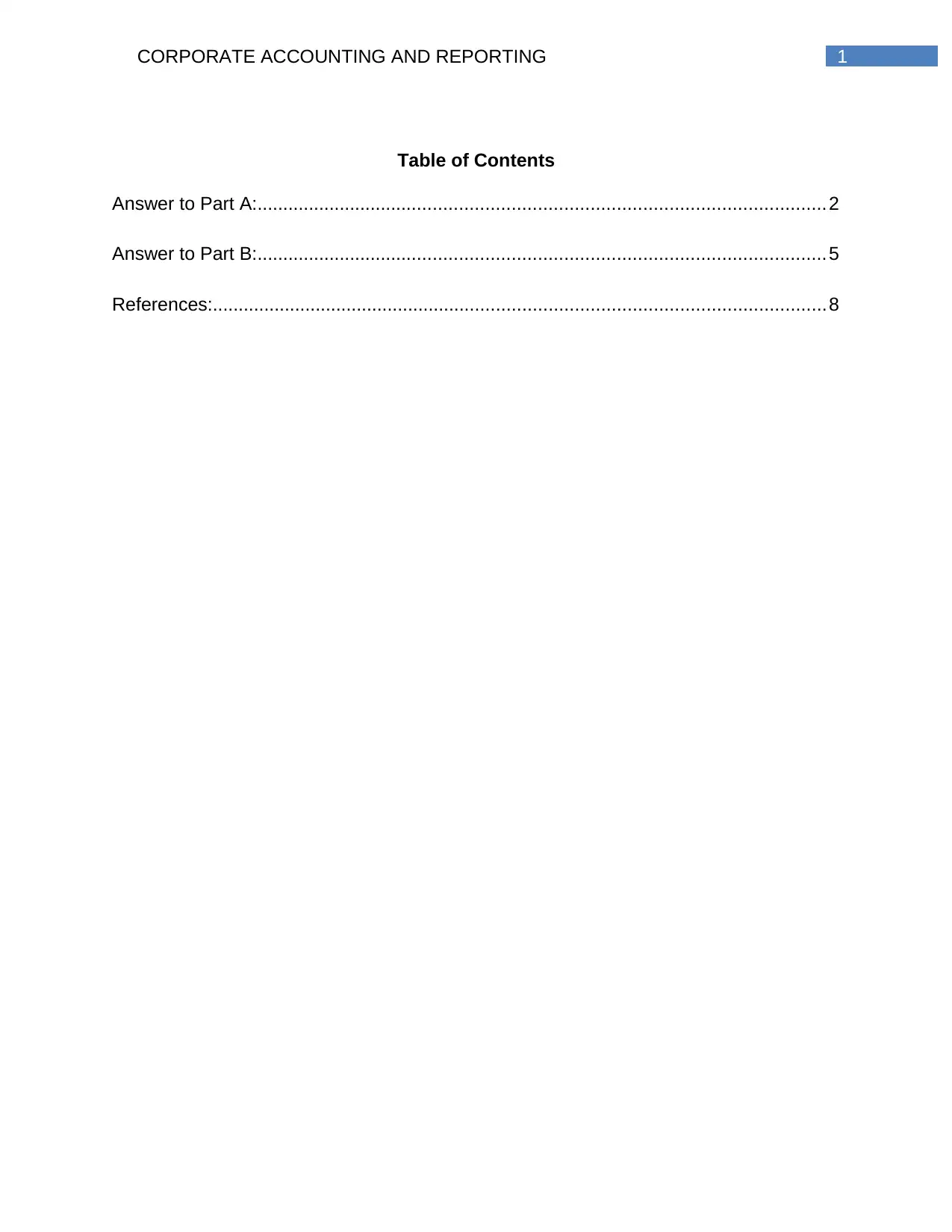
1CORPORATE ACCOUNTING AND REPORTING
Table of Contents
Answer to Part A:.............................................................................................................2
Answer to Part B:.............................................................................................................5
References:......................................................................................................................8
Table of Contents
Answer to Part A:.............................................................................................................2
Answer to Part B:.............................................................................................................5
References:......................................................................................................................8

2CORPORATE ACCOUNTING AND REPORTING
Answer to Part A:
According to “IAS 36 Impairment of Assets”, it is assured that an asset is not
brought on the balance sheet statement at a value, which is greater compared to the
recoverable amount of the stated asset. This essay aims to focus on appraising the
situations in which there is occurrence of impairment loss along with explaining the time
the organisation needs to perform the impairment review of assets. As commented by
Baboukardos and Rimmel (2014), impairment is expected to happen at the time the
carrying amount is greater in contrast to recoverable amount. The recoverable amount
includes the net sales price of the asset, value in use and fair value in compliance with
IFRS 13.
After the end of each reporting year, an organisation needs to assess whether
any indication of impairment is inherent or not. In case, there is an indication of
impairment, it is necessary to compute the recoverable amount of the asset (Damian et
al. 2014). The realisation of impairment loss is inherent, in which the recoverable
amount is lower in contrast to the carrying amount. It needs to be realised immediately
as expenditure, unless it associates with a re-valued asset, in which the impairment loss
is considered as revaluation decrease. For goodwill, the cash-generating unit to which
goodwill has been apportioned needs to be tested for annual impairment by contrasting
the unit’s carrying amount along with its recoverable amount. In either situation, if the
recoverable amount of the unit is below its carrying amount, the organisation needs to
realise impairment loss. In the past, IFRS needs realisation of goodwill subject to
amortisation over the useful lifetime (Guthrie and Pang 2013).
Answer to Part A:
According to “IAS 36 Impairment of Assets”, it is assured that an asset is not
brought on the balance sheet statement at a value, which is greater compared to the
recoverable amount of the stated asset. This essay aims to focus on appraising the
situations in which there is occurrence of impairment loss along with explaining the time
the organisation needs to perform the impairment review of assets. As commented by
Baboukardos and Rimmel (2014), impairment is expected to happen at the time the
carrying amount is greater in contrast to recoverable amount. The recoverable amount
includes the net sales price of the asset, value in use and fair value in compliance with
IFRS 13.
After the end of each reporting year, an organisation needs to assess whether
any indication of impairment is inherent or not. In case, there is an indication of
impairment, it is necessary to compute the recoverable amount of the asset (Damian et
al. 2014). The realisation of impairment loss is inherent, in which the recoverable
amount is lower in contrast to the carrying amount. It needs to be realised immediately
as expenditure, unless it associates with a re-valued asset, in which the impairment loss
is considered as revaluation decrease. For goodwill, the cash-generating unit to which
goodwill has been apportioned needs to be tested for annual impairment by contrasting
the unit’s carrying amount along with its recoverable amount. In either situation, if the
recoverable amount of the unit is below its carrying amount, the organisation needs to
realise impairment loss. In the past, IFRS needs realisation of goodwill subject to
amortisation over the useful lifetime (Guthrie and Pang 2013).
⊘ This is a preview!⊘
Do you want full access?
Subscribe today to unlock all pages.

Trusted by 1+ million students worldwide
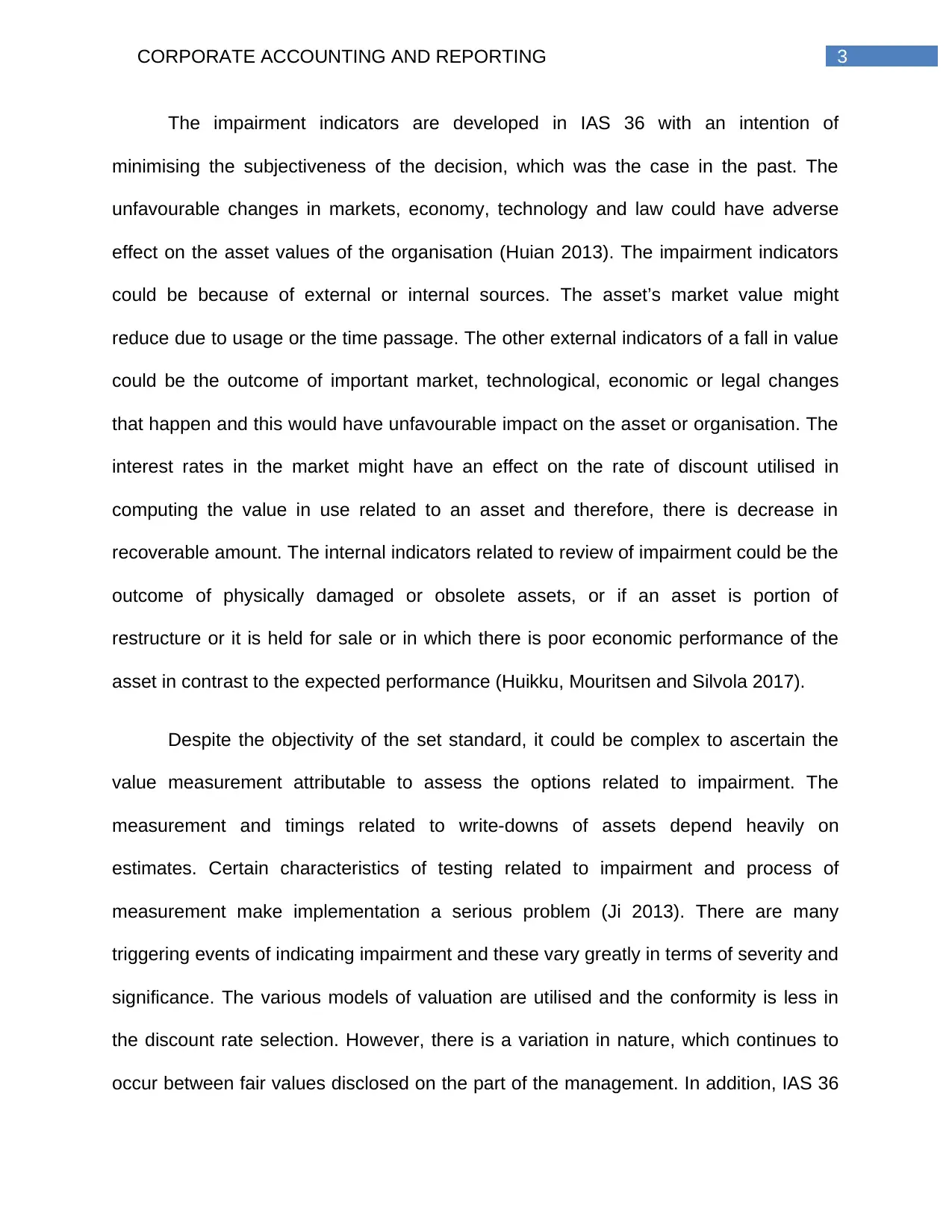
3CORPORATE ACCOUNTING AND REPORTING
The impairment indicators are developed in IAS 36 with an intention of
minimising the subjectiveness of the decision, which was the case in the past. The
unfavourable changes in markets, economy, technology and law could have adverse
effect on the asset values of the organisation (Huian 2013). The impairment indicators
could be because of external or internal sources. The asset’s market value might
reduce due to usage or the time passage. The other external indicators of a fall in value
could be the outcome of important market, technological, economic or legal changes
that happen and this would have unfavourable impact on the asset or organisation. The
interest rates in the market might have an effect on the rate of discount utilised in
computing the value in use related to an asset and therefore, there is decrease in
recoverable amount. The internal indicators related to review of impairment could be the
outcome of physically damaged or obsolete assets, or if an asset is portion of
restructure or it is held for sale or in which there is poor economic performance of the
asset in contrast to the expected performance (Huikku, Mouritsen and Silvola 2017).
Despite the objectivity of the set standard, it could be complex to ascertain the
value measurement attributable to assess the options related to impairment. The
measurement and timings related to write-downs of assets depend heavily on
estimates. Certain characteristics of testing related to impairment and process of
measurement make implementation a serious problem (Ji 2013). There are many
triggering events of indicating impairment and these vary greatly in terms of severity and
significance. The various models of valuation are utilised and the conformity is less in
the discount rate selection. However, there is a variation in nature, which continues to
occur between fair values disclosed on the part of the management. In addition, IAS 36
The impairment indicators are developed in IAS 36 with an intention of
minimising the subjectiveness of the decision, which was the case in the past. The
unfavourable changes in markets, economy, technology and law could have adverse
effect on the asset values of the organisation (Huian 2013). The impairment indicators
could be because of external or internal sources. The asset’s market value might
reduce due to usage or the time passage. The other external indicators of a fall in value
could be the outcome of important market, technological, economic or legal changes
that happen and this would have unfavourable impact on the asset or organisation. The
interest rates in the market might have an effect on the rate of discount utilised in
computing the value in use related to an asset and therefore, there is decrease in
recoverable amount. The internal indicators related to review of impairment could be the
outcome of physically damaged or obsolete assets, or if an asset is portion of
restructure or it is held for sale or in which there is poor economic performance of the
asset in contrast to the expected performance (Huikku, Mouritsen and Silvola 2017).
Despite the objectivity of the set standard, it could be complex to ascertain the
value measurement attributable to assess the options related to impairment. The
measurement and timings related to write-downs of assets depend heavily on
estimates. Certain characteristics of testing related to impairment and process of
measurement make implementation a serious problem (Ji 2013). There are many
triggering events of indicating impairment and these vary greatly in terms of severity and
significance. The various models of valuation are utilised and the conformity is less in
the discount rate selection. However, there is a variation in nature, which continues to
occur between fair values disclosed on the part of the management. In addition, IAS 36
Paraphrase This Document
Need a fresh take? Get an instant paraphrase of this document with our AI Paraphraser
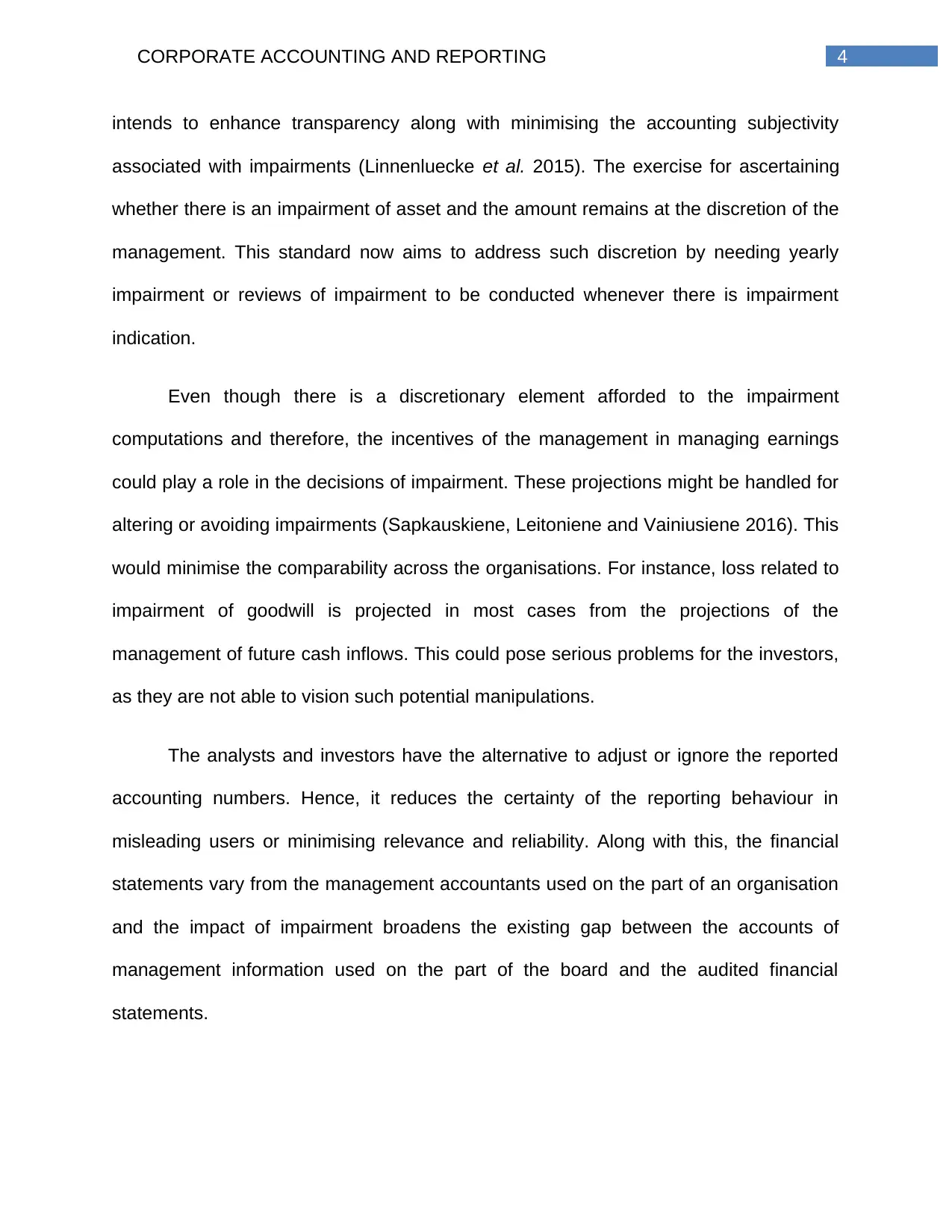
4CORPORATE ACCOUNTING AND REPORTING
intends to enhance transparency along with minimising the accounting subjectivity
associated with impairments (Linnenluecke et al. 2015). The exercise for ascertaining
whether there is an impairment of asset and the amount remains at the discretion of the
management. This standard now aims to address such discretion by needing yearly
impairment or reviews of impairment to be conducted whenever there is impairment
indication.
Even though there is a discretionary element afforded to the impairment
computations and therefore, the incentives of the management in managing earnings
could play a role in the decisions of impairment. These projections might be handled for
altering or avoiding impairments (Sapkauskiene, Leitoniene and Vainiusiene 2016). This
would minimise the comparability across the organisations. For instance, loss related to
impairment of goodwill is projected in most cases from the projections of the
management of future cash inflows. This could pose serious problems for the investors,
as they are not able to vision such potential manipulations.
The analysts and investors have the alternative to adjust or ignore the reported
accounting numbers. Hence, it reduces the certainty of the reporting behaviour in
misleading users or minimising relevance and reliability. Along with this, the financial
statements vary from the management accountants used on the part of an organisation
and the impact of impairment broadens the existing gap between the accounts of
management information used on the part of the board and the audited financial
statements.
intends to enhance transparency along with minimising the accounting subjectivity
associated with impairments (Linnenluecke et al. 2015). The exercise for ascertaining
whether there is an impairment of asset and the amount remains at the discretion of the
management. This standard now aims to address such discretion by needing yearly
impairment or reviews of impairment to be conducted whenever there is impairment
indication.
Even though there is a discretionary element afforded to the impairment
computations and therefore, the incentives of the management in managing earnings
could play a role in the decisions of impairment. These projections might be handled for
altering or avoiding impairments (Sapkauskiene, Leitoniene and Vainiusiene 2016). This
would minimise the comparability across the organisations. For instance, loss related to
impairment of goodwill is projected in most cases from the projections of the
management of future cash inflows. This could pose serious problems for the investors,
as they are not able to vision such potential manipulations.
The analysts and investors have the alternative to adjust or ignore the reported
accounting numbers. Hence, it reduces the certainty of the reporting behaviour in
misleading users or minimising relevance and reliability. Along with this, the financial
statements vary from the management accountants used on the part of an organisation
and the impact of impairment broadens the existing gap between the accounts of
management information used on the part of the board and the audited financial
statements.
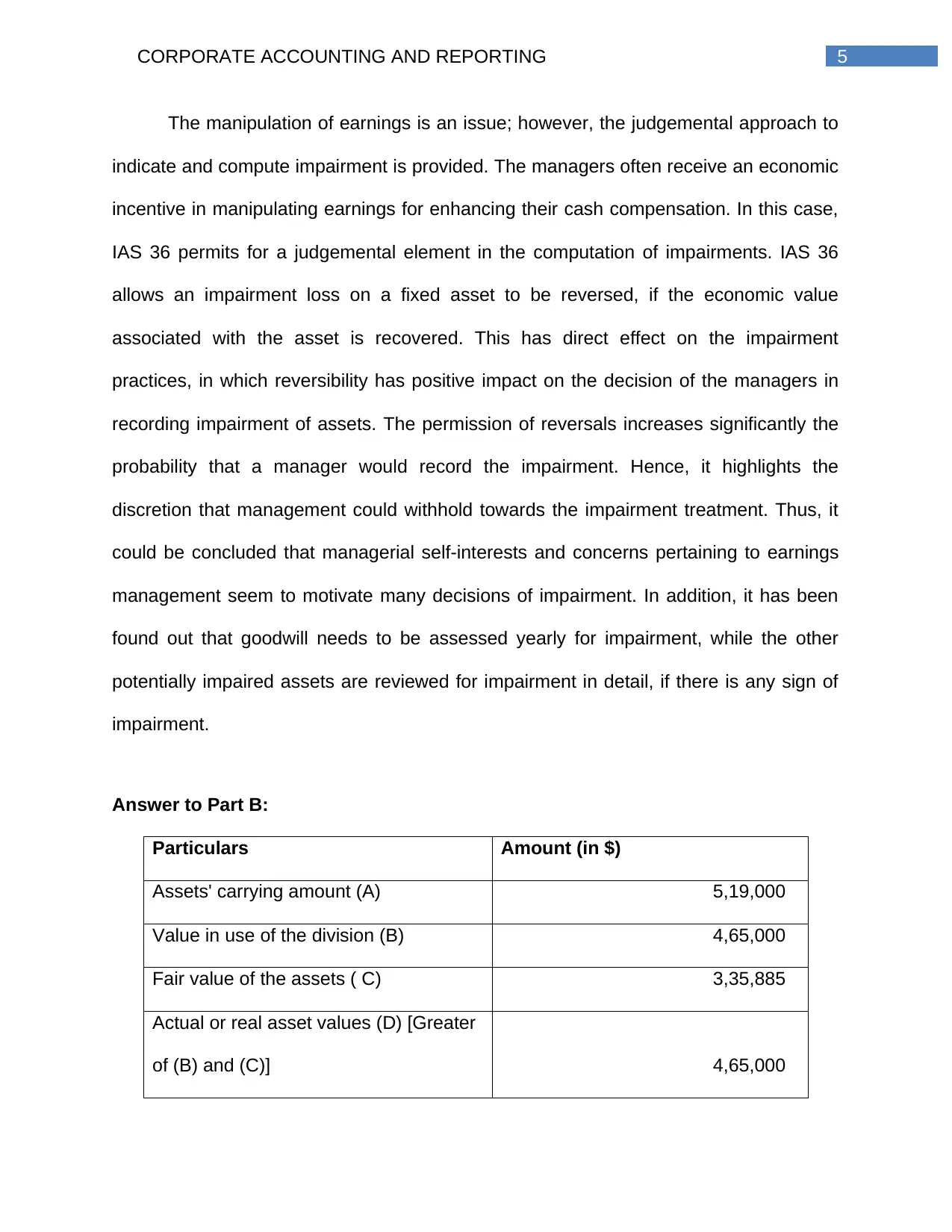
5CORPORATE ACCOUNTING AND REPORTING
The manipulation of earnings is an issue; however, the judgemental approach to
indicate and compute impairment is provided. The managers often receive an economic
incentive in manipulating earnings for enhancing their cash compensation. In this case,
IAS 36 permits for a judgemental element in the computation of impairments. IAS 36
allows an impairment loss on a fixed asset to be reversed, if the economic value
associated with the asset is recovered. This has direct effect on the impairment
practices, in which reversibility has positive impact on the decision of the managers in
recording impairment of assets. The permission of reversals increases significantly the
probability that a manager would record the impairment. Hence, it highlights the
discretion that management could withhold towards the impairment treatment. Thus, it
could be concluded that managerial self-interests and concerns pertaining to earnings
management seem to motivate many decisions of impairment. In addition, it has been
found out that goodwill needs to be assessed yearly for impairment, while the other
potentially impaired assets are reviewed for impairment in detail, if there is any sign of
impairment.
Answer to Part B:
Particulars Amount (in $)
Assets' carrying amount (A) 5,19,000
Value in use of the division (B) 4,65,000
Fair value of the assets ( C) 3,35,885
Actual or real asset values (D) [Greater
of (B) and (C)] 4,65,000
The manipulation of earnings is an issue; however, the judgemental approach to
indicate and compute impairment is provided. The managers often receive an economic
incentive in manipulating earnings for enhancing their cash compensation. In this case,
IAS 36 permits for a judgemental element in the computation of impairments. IAS 36
allows an impairment loss on a fixed asset to be reversed, if the economic value
associated with the asset is recovered. This has direct effect on the impairment
practices, in which reversibility has positive impact on the decision of the managers in
recording impairment of assets. The permission of reversals increases significantly the
probability that a manager would record the impairment. Hence, it highlights the
discretion that management could withhold towards the impairment treatment. Thus, it
could be concluded that managerial self-interests and concerns pertaining to earnings
management seem to motivate many decisions of impairment. In addition, it has been
found out that goodwill needs to be assessed yearly for impairment, while the other
potentially impaired assets are reviewed for impairment in detail, if there is any sign of
impairment.
Answer to Part B:
Particulars Amount (in $)
Assets' carrying amount (A) 5,19,000
Value in use of the division (B) 4,65,000
Fair value of the assets ( C) 3,35,885
Actual or real asset values (D) [Greater
of (B) and (C)] 4,65,000
⊘ This is a preview!⊘
Do you want full access?
Subscribe today to unlock all pages.

Trusted by 1+ million students worldwide

6CORPORATE ACCOUNTING AND REPORTING
Loss from Impairment (E) (A) - (D)] 54,000
Goodwill on acquisition of competing
organisations (F) -
Impairment loss from subtraction of
goodwill (E) - (F) 54,000
Apportionment of Impairment Loss
Particulars Amount (in $) Percentage Impairment (in $)
Patent 3,49,000 67% 36,312
Equipment 80,000 15% 8,324
Fittings 50,000 10% 5,202
Inventory 22,000 4% 2,289
Goodwill 18,000 3% 1,873
Total Amount of Assets 5,19,000 100% 54,000
In the books of Gali Limited
Journal Entry as on 30 June 2015
Debit Credit
Date Particulars Amount (in $) Amount (in $)
30-
Jun-
15
Impairment Loss
Account……….Dr
54,000
To Goodwill Account
Loss from Impairment (E) (A) - (D)] 54,000
Goodwill on acquisition of competing
organisations (F) -
Impairment loss from subtraction of
goodwill (E) - (F) 54,000
Apportionment of Impairment Loss
Particulars Amount (in $) Percentage Impairment (in $)
Patent 3,49,000 67% 36,312
Equipment 80,000 15% 8,324
Fittings 50,000 10% 5,202
Inventory 22,000 4% 2,289
Goodwill 18,000 3% 1,873
Total Amount of Assets 5,19,000 100% 54,000
In the books of Gali Limited
Journal Entry as on 30 June 2015
Debit Credit
Date Particulars Amount (in $) Amount (in $)
30-
Jun-
15
Impairment Loss
Account……….Dr
54,000
To Goodwill Account
Paraphrase This Document
Need a fresh take? Get an instant paraphrase of this document with our AI Paraphraser

7CORPORATE ACCOUNTING AND REPORTING
1,873
To Patent Account
36,312
To Equipment Account
8,324
To Fittings Account
5,202
To Inventory Account
2,289
(Net assets, liabilities and
goodwill impaired depending
on the amount of recovery)
30-
Jun-
15
Income Statement
Account………………..Dr
54,000
To Impairment Loss Account 54,000
( Value of impairment loss
reallocated to the income
statement)
1,873
To Patent Account
36,312
To Equipment Account
8,324
To Fittings Account
5,202
To Inventory Account
2,289
(Net assets, liabilities and
goodwill impaired depending
on the amount of recovery)
30-
Jun-
15
Income Statement
Account………………..Dr
54,000
To Impairment Loss Account 54,000
( Value of impairment loss
reallocated to the income
statement)
1 out of 8
Related Documents
Your All-in-One AI-Powered Toolkit for Academic Success.
+13062052269
info@desklib.com
Available 24*7 on WhatsApp / Email
![[object Object]](/_next/static/media/star-bottom.7253800d.svg)
Unlock your academic potential
Copyright © 2020–2025 A2Z Services. All Rights Reserved. Developed and managed by ZUCOL.





